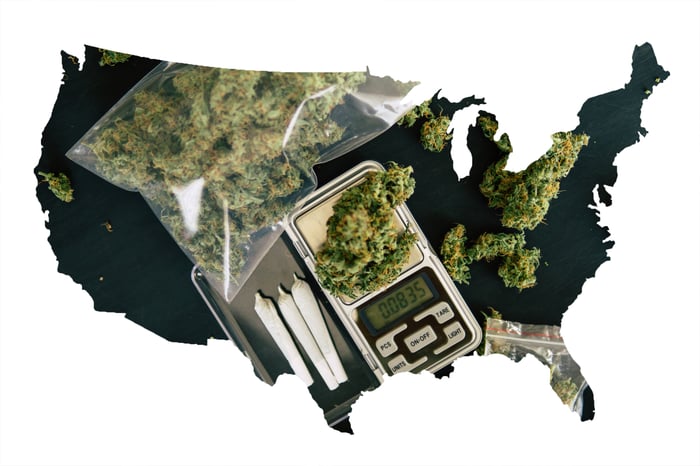Although the marijuana industry has seen its hiccups of late, long-term pot stock investors have little to complain about. Investors with the foresight, wherewithal, and luck to buy into some of the most popular marijuana stocks have seen enormous gains in recent years. And based on the potential of the industry, this growth is just getting started.
Cannabis industry cheerleader Cowen Group, which has arguably been covering pot stocks longer than any Wall Street investment firm, believes that the industry could hit $75 billion in global sales by 2030, which would represent a more than sixfold increase in global sales from 2018, according to data from Arcview Market Research and BDS Analytics.
Meanwhile, Christopher Carey at Bank of America believes that the cannabis industry has the potential to one day hit $166 billion in annual sales, all while disrupting industries that currently rake in $2.6 trillion a year. Carey is looking for Canada to account for about 3% of this global utopian total (about $5 billion), with the U.S. representing 34% of the addressable cannabis market ($56 billion).

Image source: Getty Images.
Holy cannabis growth, Batman!
But neither of these optimistic forecasts can hold a candle to the projection Wall Street firm Stifel and covering analyst Andrew Carter put out at the beginning of this month. According to Stifel, the cannabis industry could gallop to $200 billion in yearly sales... in a decade. That's well over double what Cowen Group has forecast, and it's about four times what Jefferies is looking for in annual sales by 2029.
Where on Earth will this growth come from? The report put out by Carter to clients suggests that Canada offers the most intriguing near-term opportunity, primarily because it's the only developed country in the world to have given the green light to adult-use marijuana. Stifel is forecasting sales of 10 billion Canadian dollars ($7.6 billion) by 2023. For context, Canadian cannabis store sales hit $56.6 million in April, and have tallied just $308.3 million in the first 6.5 months of sales since recreational legalization took hold in our neighbor to the north.
The considerably bigger catalyst is the United States, which Stifel and Carter see contributing about $100 billion a year in sales a decade from now. This opportunity certainly won't blossom overnight. In fact, Carter points out that the earliest opportunity for cannabis reform in the U.S. is 2021 given that Senate Majority Leader Mitch McConnell (R-Ky.) has continuously blocked marijuana legislation from reaching the Senate floor for vote. But based on these projections, Carter is implying that eventual U.S. legalization would lead to very rapid growth in pot sales.

Image source: Getty Images.
Take note of Stifel's top cannabis stock
And what marijuana stock does Stifel believe offers investors the best opportunity to take advantage of this $200 billion in annual sales? None other than the largest marijuana stock in the world by market, Canopy Growth (CGC -10.51%). Said Carter in the report to clients:
While the near-term execution at Canopy is underwhelming [and] likely driving a portion of the elevated expenses, we remain confident that Canopy is best positioned to tackle all avenues for growth in the $200 billion global category.
Within Canada, Canopy Growth has 5.6 million square feet set aside for cultivation, of which more than 4.8 million square feet is already licensed. Given the monumental delays at Health Canada in approving license applications, the fact that Canopy has been this successful in getting its grow farms licensed is a testament of just how far it is ahead of many of its competitors. Not to mention, Canopy will likely slide in as Canada's second-largest grower, making it an instant hit in our neighbor to the north.
However, Canopy Growth has also been actively pushing into the United States. In January, the company was awarded a hemp-processing license in New York State and will be spending up to $150 million to construct a processing facility. It also anticipates moving its hemp-processing capabilities into more than a half-dozen U.S. states. While the U.S. cannabidiol (CBD) market will be huge, the real lure for Canopy is the ability get processing infrastructure in place on U.S. soil ahead of an expected legalization of cannabis years down the road.
Canopy Growth is also acquiring Acreage Holdings (ACRGF) on a contingent-rights basis for $3.4 billion in cash and stock. Though Canopy is paying Acreage shareholders $300 million up front, the transaction only completes on the contingency that the U.S. legalizes marijuana at the federal level. With a 90-month window on this deal, Canopy is aiming to take advantage of Acreage Holdings' presence in 20 states (on a pro forma basis), as well as its nearly 90 retail store licenses.

Image source: Getty Images.
A mammoth international opportunity, too
Though Carter primarily focuses on Canada and the United States -- and rightly so, as these two countries could account for close to 55% of global pot sales in a decade -- don't overlook that more than $90 billion in forecast sales (assuming Stifel's projection is accurate) will come from the overseas market.
Aurora Cannabis (ACB -4.85%), the only Canadian grower that's expected to produce more weed per year at peak capacity than Canopy Growth, is one such name that could thrive internationally. Between production, exports, distribution, and research agreements, Aurora has a presence in two dozen countries, including Canada.
The thing is, Aurora Cannabis isn't going to see much of a benefit from this international presence until demand in the domestic Canadian market is saturated. Only when dried flower oversupply and/or commoditization hits will the true benefit of these external sales channels really bear fruit for the company.
Nevertheless, with more than $90 billion on the line outside of Canada and the U.S., there should, presumably, be plenty of opportunity for Aurora to really excel by the midpoint of the next decade. Best of all, the presumption is that a good chunk of these external sales will be for medical cannabis, which tends to sport a higher price point and better margins than recreational marijuana.
Whether its Aurora Cannabis or another global pot stock that you fancy, the gist is that marijuana could be a once-in-a-generation growth opportunity, so ensure that it's on your radar.





